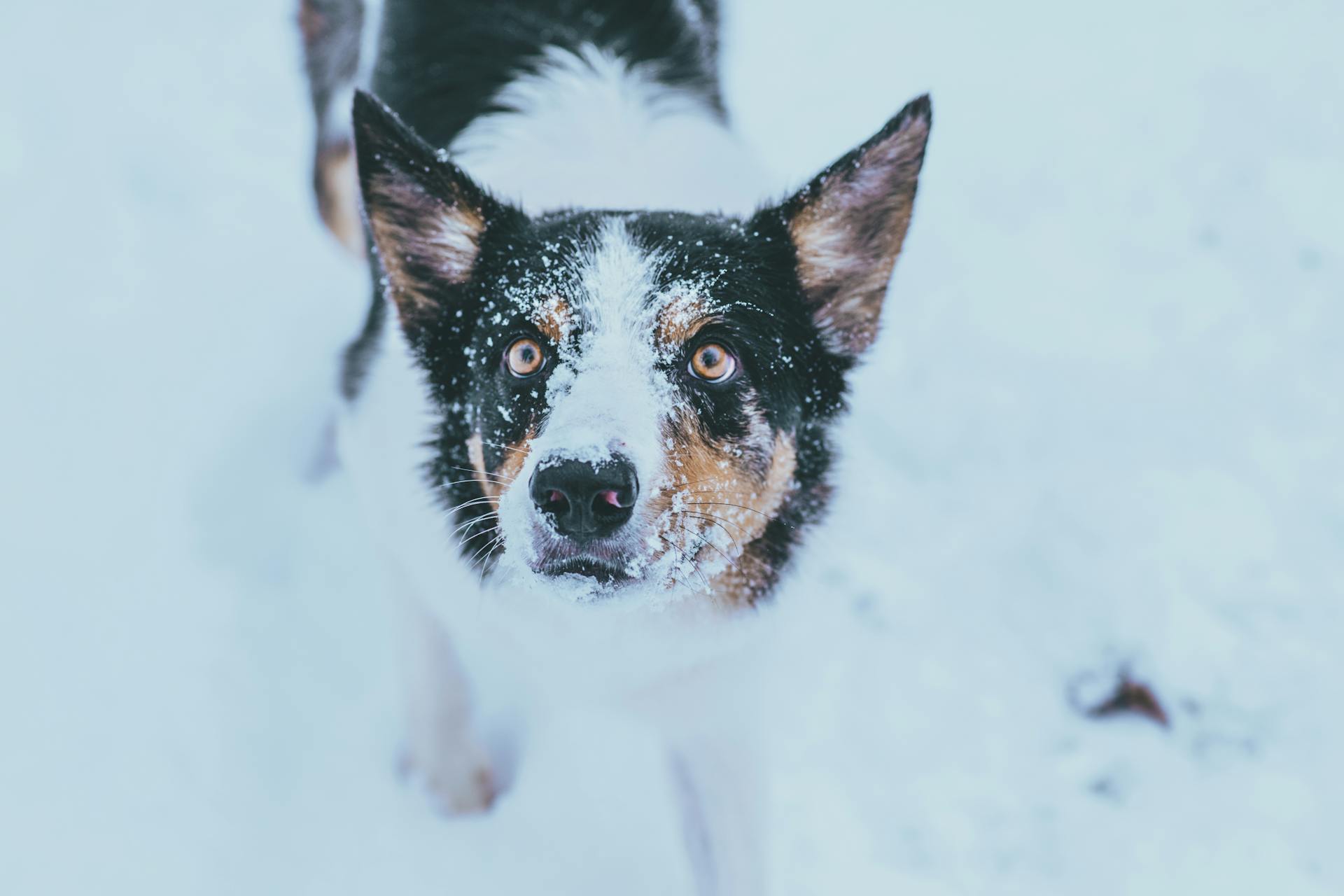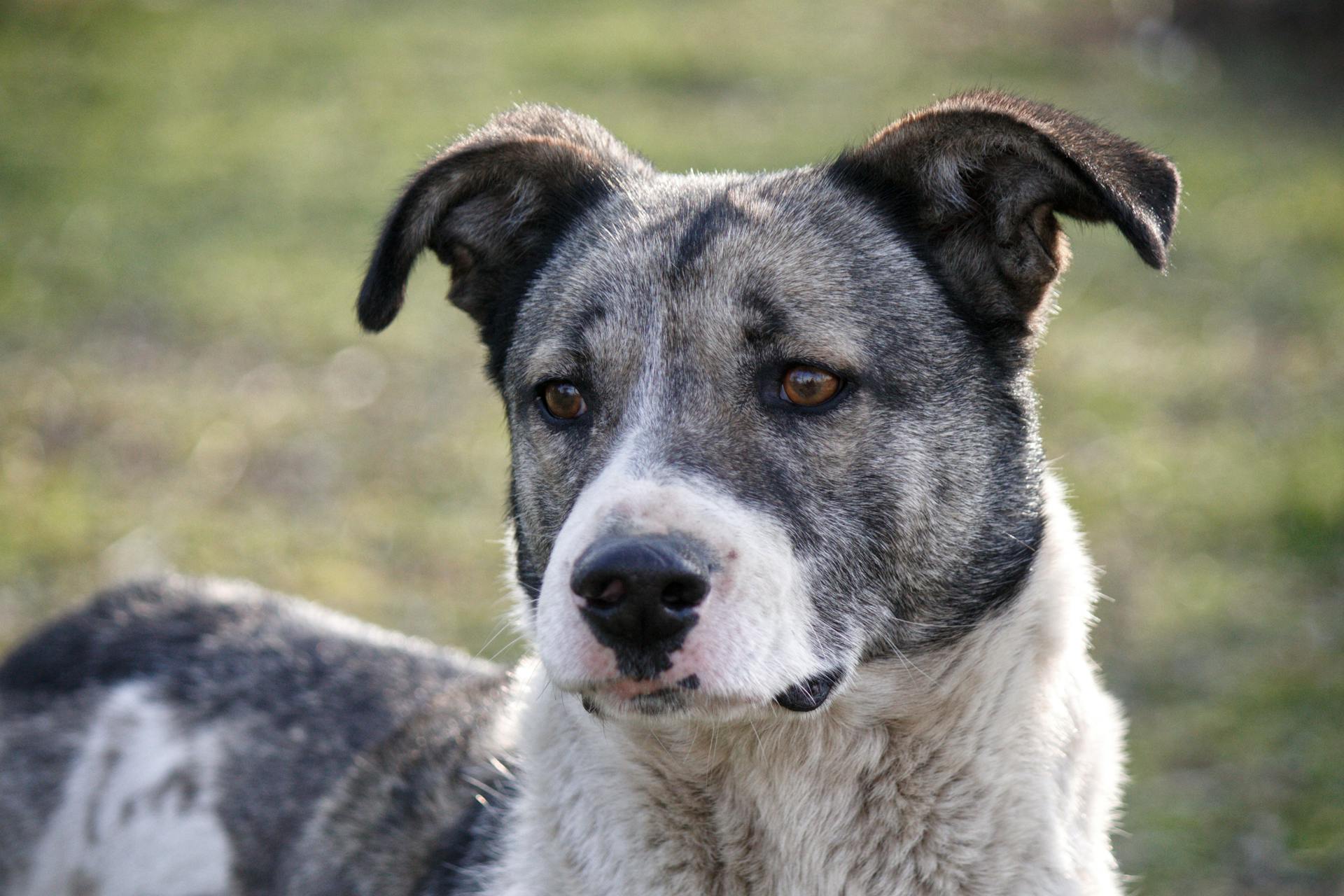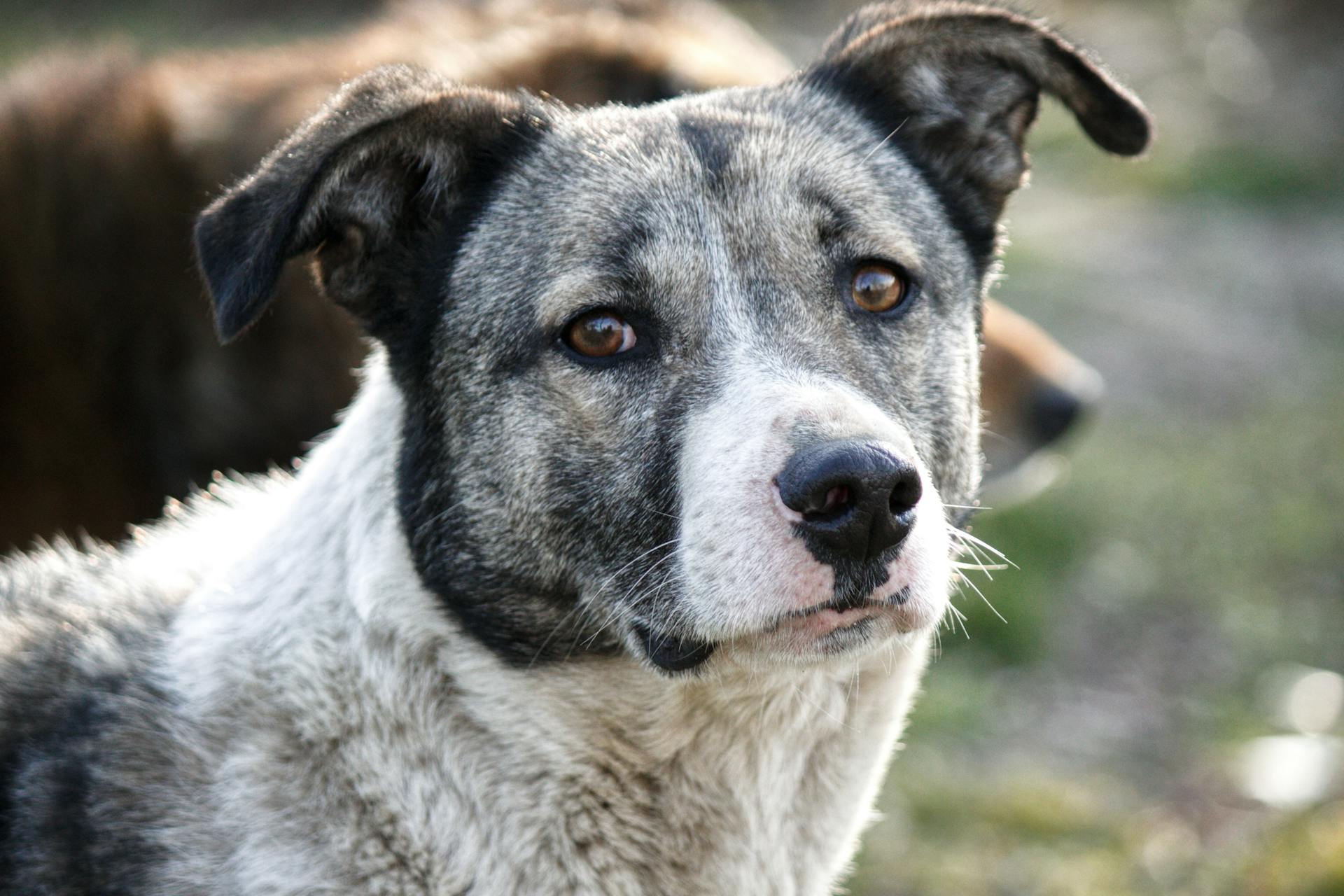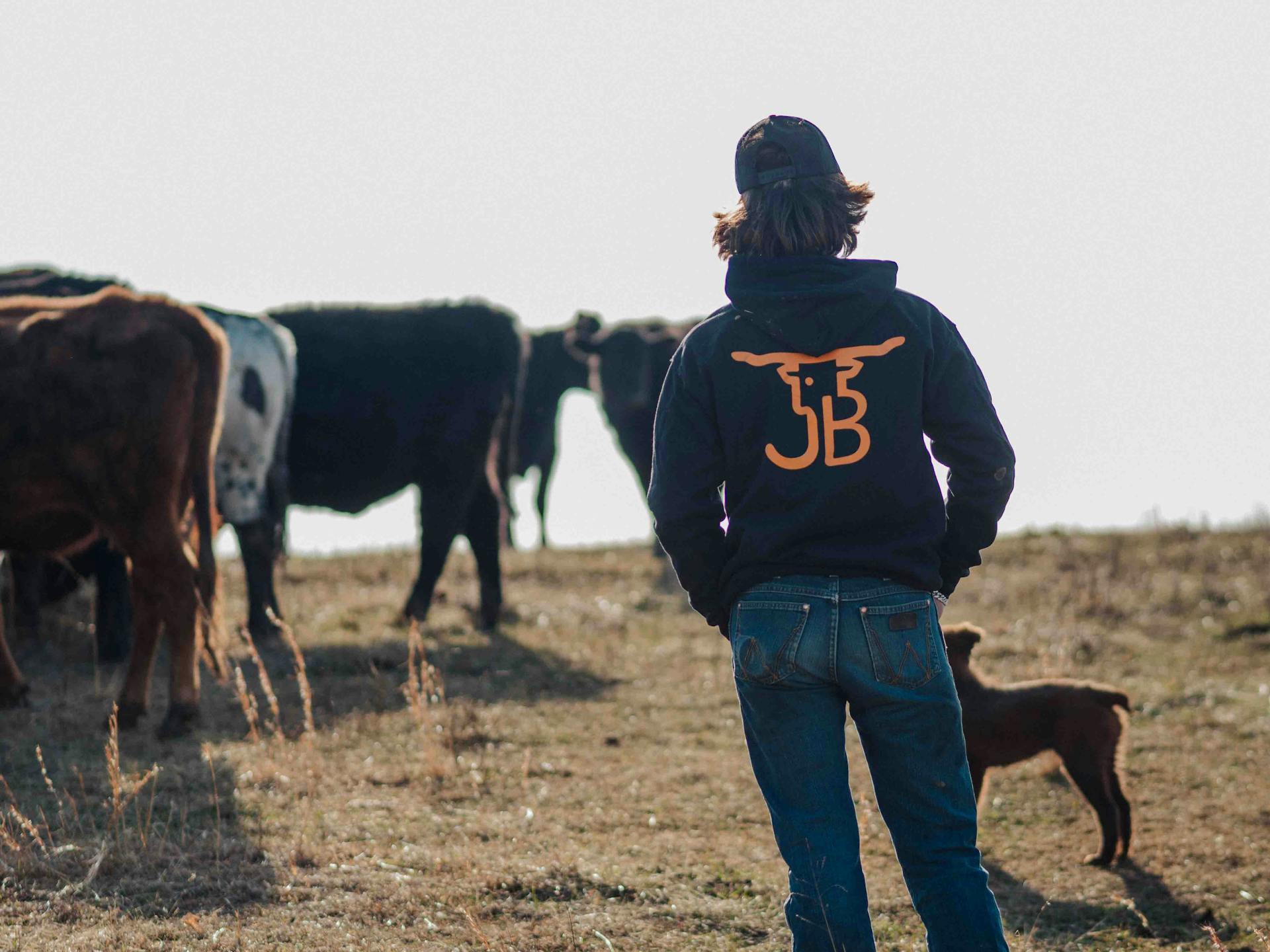
The Blue Heeler Shepherd is a crossbreed between an Australian Cattle Dog and a German Shepherd, making it a unique and energetic companion.
This breed is known for its intelligence and loyalty, often forming strong bonds with their owners.
They require regular exercise and mental stimulation to prevent boredom and destructive behavior.
A 30-minute walk and 30 minutes of playtime can be a good starting point, but be prepared to increase the duration as they grow older.
Blue Heeler Shepherds are generally healthy, but they can be prone to hip dysplasia and eye problems, so regular check-ups with a veterinarian are essential.
Care and Maintenance
The Australian Cattle Dog is a high-energy breed that requires daily exercise, and it loves long hikes, jogs, and vigorous games.
To keep your Blue Heeler happy and healthy, make sure to provide it with a securely fenced yard or a country farm or ranch where it can roam and exercise freely.
This breed is prone to hip dysplasia, so it's essential to feed a large-breed puppy food that slows down its growth rate to reduce the risk of developing this condition.
The Australian Cattle Dog's coat is thick and requires occasional brushing to remove dead hairs, which are abundant during its two shedding seasons in fall and spring.
Regular grooming is also crucial to prevent matting or tangling of the coat, so brush your Blue Heeler weekly to keep it looking its best.
You should also brush its teeth two or three times a week to prevent bad breath and tartar buildup, and daily brushing is even better to prevent gum disease.
Trimming its nails every two weeks is also necessary to keep its feet in good condition, and cleaning its ears regularly will help prevent infections.
Early socialization and training are vital to ensure your Australian Cattle Dog grows up to be a well-rounded dog, so start teaching it basic manners and obedience training as soon as possible.
The Blue Heeler Australian Shepherd cross is a relatively low-maintenance breed, but it still needs regular grooming to prevent matting and tangling of its coat.
By following these simple care and maintenance tips, you can keep your Blue Heeler happy, healthy, and well-groomed, and enjoy a strong and loving bond with your furry companion.
Here's an interesting read: How to Raise a Blue Heeler Puppy
Temperament and Personality
The Blue Heeler Shepherd is a loyal and devoted companion, but it's essential to understand its temperament and personality traits to ensure a harmonious household. They are intelligent and can be trained with positive reinforcement techniques, which is crucial for managing their herding instincts.
With early socialization, they can seamlessly integrate into households, particularly those with children. However, their herding instincts may lead them to try herding children, so early training is necessary to address nipping tendencies.
They are also fiercely loyal and protective of their family, making them excellent watchdogs. But, they can be suspicious of strangers and may be aggressive toward strange dogs, so it's crucial to socialize them properly.
Here are some key temperament and personality traits to consider:
- Intelligent and trainable with positive reinforcement techniques
- Loyal and devoted to their families
- Fiercely protective of their family and territory
- May try to herd children and other animals due to their herding instincts
- Need early socialization to integrate into households
Overall, the Blue Heeler Shepherd is a wonderful companion for active families who are willing to invest time in training and socialization. With the right care and attention, they can thrive and become a beloved member of the family.
Temperament and Personality
The Australian Cattle Dog is a tough and rugged breed that requires a firm hand. They're intelligent and learn quickly, but can be independent and headstrong.
These dogs are high-energy and enjoy both physical and mental challenges. They need constant mental and physical activity to prevent boredom and destructive behavior.
Australian Cattle Dogs are loyal to their family and usually aloof with strangers. They eventually accept regular visitors into their homes but don't expect them to be overly excited or affectionate with anyone outside their central family unit.
They're protective of their family and courageous in the face of danger. With good training, they're level-headed and obedient.
Here are some key characteristics of the Australian Cattle Dog's temperament and personality:
They're also known to be reserved with strangers, but devoted to their owner and family. Once they bond, they like to go wherever their owner goes, and punishment to them is physical separation from those they love.
Their intelligence and trainability make them excellent companions for active owners who can provide the necessary exercise and mental stimulation.
Size and Appearance

They typically stand between 17 to 24 inches tall, from paw to shoulder.
German Shepherd Blue Heeler mixes usually weigh between 30 to 80 pounds.
Males stand 18 to 20 inches tall, and females stand 17 to 19 inches tall.
Their weight range is quite broad, but they're generally considered medium to large dogs.
Some German Blue Heelers might sport one eye blue and the other brown, a beautiful trait known as heterochromia.
Their eyes are usually brown, although they can inherit the blue color seen in the Cattle Dog.
They often have large, triangular, erect ears and a long tail.
Recommended read: Brown Blue Heeler
Three Reasons to Get
If you're considering bringing a blue heeler shepherd into your family, here are three reasons to get one.
They make great guard dogs, being loyal and very protective, especially when it comes to their family.
Their intelligence makes them quick learners, perfect for owners who have experience and leadership skills to guide them.
For another approach, see: Blue Heeler as Family Dog
You'll have no problems training this hybrid, as long as you have the experience and leadership skills it needs in an alpha.
A blue heeler shepherd is always alert, adventurous, and energetic, making them the ideal companion for someone with an active lifestyle.
You'll only need to brush their fur weekly, and they shed in moderate amounts, so grooming is a breeze.
They love learning new things and exploring new challenges, so training is a fun and rewarding experience.
Their protective nature makes them very affectionate to their owner and family, and they'll only bark at true intruders and strangers.
Here are some key characteristics of the blue heeler shepherd:
Practical Considerations
If you live in a rural area or have a large yard, a Blue Heeler Shepherd is a perfect fit. They need space to run around and engage in outdoor activities.
Their exercise requirements are quite high, with a minimum of 14 miles per week and 90 minutes of daily activity. This is because they were bred to herd and need to stay active.
A 30-minute walk, twice a day, is a great way to keep them exercised and happy.
Exercise Needs
If you're considering bringing home a Blue Heeler mix, be prepared for a dog that's always on the go. They need at least 60 to 90 minutes of daily exercise to meet their needs.
A long stroll around the neighborhood just won't cut it - they need challenging and intensive activities to keep them happy and healthy.
Their larger size and high exercise needs mean they're not suited to apartment living. They do much better in larger homes with access to a yard, giving them space to play and run between exercise sessions.
Their yard must be secure, and your fences must be high because they can be excellent jumpers. Otherwise, they will likely escape, herding anything they can.
A minimum of two walks a day is a good starting point, but that's just the beginning. They'll also need ample space to run around and play to release their seemingly boundless energy.

Playing games like Tug of War and Frisbee will bring happiness to your dog and strengthen your relationship. Puzzles, chew toys, and tug toys are ideal for keeping them engaged and stimulated.
Their required mileage per week is at least 14 miles, and daily required activity time is 90 minutes.
Farm
If you're considering bringing a Blue Heeler onto your farm, you'll want to know their work ethic is strong - they herd everything in sight.
They're particularly good at working on ranches, but that doesn't mean they're a low-maintenance pet. They'll need regular exercise and mental stimulation to keep them happy and healthy.
In terms of size, Blue Heelers are relatively small, weighing between 35 and 50 pounds and measuring between 17 and 20 inches tall. This makes them a great choice for smaller farms or homesteads.
Their protective nature can be a plus on a farm, but it's essential to socialize them well to prevent aloofness around strangers. With proper training and care, they'll be a loyal and loving companion.
Additional Considerations Before Adoption

Owning a dog is a big responsibility, so it's essential to consider a few key things before adoption. These pups need a very active family who can offer several hours of exercise and playtime throughout the day.
They can be stubborn and tricky to train, so they are best suited to an experienced dog owner. Dog ownership requires a significant time commitment, and if you're away from home for long periods, it may not be the best fit.
The German Shepherd Blue Heeler mix requires company for most of the day, so if you have a busy schedule, you may need to consider hiring a dog walker or asking a neighbor to check in on them. They thrive on attention and interaction, so a lonely pup is a unhappy pup.
Before taking the leap, ask yourself if you're prepared for the long-term commitment of dog ownership. It's crucial to consider your lifestyle and whether it's compatible with the needs of a dog.
Worth a look: Blue Heeler Diet
Living with a Blue Heeler Shepherd
Living with a Blue Heeler Shepherd requires a lot of physical activity. They need at least 60 to 90 minutes of daily exercise to meet their needs, making them a great choice for families who love the outdoors.
Their larger size and high exercise needs mean they're not suited to apartment living. They do much better in larger homes with access to a yard, giving them space to play and run between exercise sessions.
To keep them happy and healthy, provide them with mentally stimulating toys and activities. Two walks a day are a minimum, and they'll also need ample space to run around and play to release their boundless energy.
Here's a rough guide to their daily needs:
- 60-90 minutes of daily exercise
- Two walks a day
- Ample space to run around and play
- Mentally stimulating toys and activities
If you're considering bringing a Blue Heeler Shepherd into your family, make sure you're prepared to provide them with the love, attention, and physical activity they need. With the right care, they'll be a loyal and loving companion for years to come.
Exercise & Living Conditions
A Blue Heeler Shepherd is not a lapdog, so if you're looking for a low-maintenance pet, this breed is not for you.
They need at least 60 to 90 minutes of daily exercise to meet their needs, which is a lot of physical activity.
Their larger size and high exercise needs mean they're not suited to apartment living, so a larger home with a yard is a must.
They can be excellent jumpers, so your fences must be high and secure to prevent escape attempts.
A Blue Heeler Shepherd can live with children and other pets if socialized well as a puppy, but their herding instincts might kick in if their exercise needs aren't met.
Children must be dog-savvy and patient, as the Blue Heeler Shepherd's herding traits might not make them the most patient breed.
With the right family, they can make great family pets, but it's essential to provide them with the necessary exercise and mental stimulation.
A minimum of two walks a day is a good starting point, but they'll also need ample space to run around and play to release their boundless energy.
Playing games like Tug of War and Frisbee can bring happiness to your dog and strengthen your relationship.
Consider reading: Blue Heeler Herding Cattle
Families
Living with a Blue Heeler Shepherd can be a wonderful experience for families with older children who are willing to provide leadership and engage in active play. These dogs thrive on attention and need a lot of space to exercise, so a home with a secure backyard is a must.
A Blue Heeler Shepherd mix is not suitable for families with young children or new dog owners, as they can be too much to handle. They require a lot of physical and mental stimulation, which can be challenging for inexperienced owners.
To keep your Blue Heeler Shepherd happy and healthy, make sure to provide at least 60 to 90 minutes of challenging activity daily. This can include hiking, camping, and exploring the great outdoors, as well as playtime in the backyard.
These dogs are highly intelligent and love to please, making them relatively easy to train with consistent and positive reinforcement. However, early training is key to preventing behavioral issues.
Here's an interesting read: How Smart Are Blue Heeler Dogs
Here are some key characteristics to keep in mind when living with a Blue Heeler Shepherd:
Remember, a Blue Heeler Shepherd is a loyal and loving companion that will thrive in a family with older children who can provide the attention and exercise they need.
Health and Wellbeing
Blue Heeler Shepherds are generally healthy dogs with a lifespan of 7 to 16 years. However, they can be prone to certain health issues like their parent breeds.
Bloat, elbow and hip dysplasia, eczema, epilepsy, blindness and other eye disorders, deafness, and hemophilia are potential health concerns for Blue Heeler Shepherds. Regular exercise, high-quality nutrition, and regular health visits can help prevent or manage these conditions.
To keep your Blue Heeler Shepherd healthy, consider a pet insurance plan to cover unexpected medical expenses. Knowing the health risks and being proactive can help ensure your furry friend lives a long and happy life.
Here are some potential health concerns to look out for in Blue Heeler Shepherds:
- Bloat
- Elbow and hip dysplasia
- Eczema
- Epilepsy
- Blindness and other eye disorders
- Deafness
- Hemophilia
Health

A German Shepherd mixed with Blue Heeler can live up to 7 to 16 years, but may be prone to health problems like bloat, elbow and hip dysplasia, eczema, epilepsy, blindness, deafness, and hemophilia.
Regular exercise, high-quality nutrition, and regular health visits can help keep your pup healthy. In fact, many German Shepherd mixes tend to be healthier than their purebred GSD parent.
Some common health concerns in German Shepherd mixes include bloat, elbow and hip dysplasia, eczema, epilepsy, blindness, deafness, and hemophilia. It's essential to be aware of these potential issues and monitor your pup for any symptoms.
DNA testing can help you understand your pup's heritage and potential health problems. This can be especially helpful when selecting a puppy from a trustworthy breeder.
Here are some common health concerns in German Shepherd mixes:
- Bloat
- Elbow and hip dysplasia
- Eczema
- Epilepsy
- Blindness and other eye disorders
- Deafness
- Hemophilia
It's also a good idea to consider a pet insurance plan to help offset the costs associated with unexpected health needs. This can provide peace of mind and financial security for you and your pup.
Nutrition
Nutrition is a crucial aspect of your German Blue Heeler's overall health and wellbeing.
Following the feeding instructions on your preferred food is essential, as it gives you specific guidelines for your dog.
Overfeeding can increase pressure on their joints, cardiac system, and overall wellness.
Select a high-quality diet that meets the guidelines set by the Association of American Feed Control Officials (AAFCO).
Choose a diet that includes high-quality ingredients such as animal protein, carbs, fiber, omega fats, vitamins, and minerals.
A high-quality option like Ollie is a great choice for your furry friend.
Their nutritional needs change over time, especially during the first year when their body, particularly their joints, are developing.
Frequently Asked Questions
Are Australian Shepherd Blue Heeler mix good dogs?
Australian Shepherd Blue Heeler mixes can make loving and loyal family pets, but they require careful socialization and training to manage their strong herding instincts. With proper care, they can thrive as gentle and devoted companions.
Are Blue Heelers good family dogs?
Yes, Blue Heelers are a great fit for families with kids, known for their loyalty and gentle nature. They make excellent family dogs with their keen intelligence and pleasant temperament.
Sources
- https://www.britannica.com/animal/Australian-cattle-dog
- https://www.alphapaw.com/dog-breeds/blue-heeler-german-shepherd-mix/
- https://www.caninejournal.com/blue-heeler-german-shepherd-mix/
- https://www.alphapaw.com/dog-breeds/australian-shepherd-blue-heeler-mix/
- https://dogtime.com/dog-breeds/australian-cattle-dog
Featured Images: pexels.com


